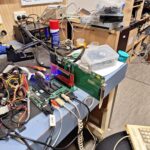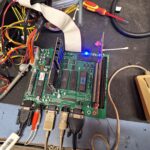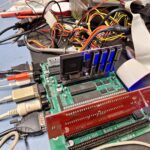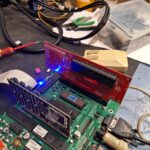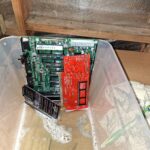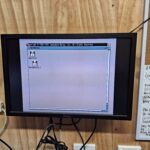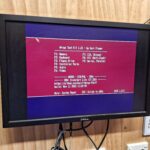This is the SMD2000 “BUSHFIRE”, a mini-DTX sized edition of the Amiga 2000. It is designed to fit into a Silverstone ML09 case.
This project was begun in July 2023 and is now nearing the end of development. With a booting prototype the time has come to announce it to the world. When the second prototype is built and I am sure everything is correct this project will be released open source for anyone to build.
Features
The motherboard has the same general A2000 features with the following changes:
Modular Design
- The Agnus, crystal, and chip ram are on a separate card to allow the same motherboard to be used regardless of which Agnus is available. More about the rationale for this below
- The CPU has been removed from the motherboard and instead goes on a card in the CPU slot.
- ISA bus removed for obvious reasons.
Power
- ATX PSU connector and latching power switch using 555 timer.
- Removed +5V_USER, +12_USER, and -12V_USER lines. The mouse and parallel ports are fed from the regular +5V line, and the redesigned video and serial ports don’t need them.
- Added option for -5V regulator in case the ATX supply does not have it. This need only be used if there is a Zorro card that requires it.
Ports
- Internal headers for Mouse and Joystick for future development of USB adapters (Joystick port is only available on the header; a standard DSUB lead is required).
- Changed serial port to DSUB9. Removed “INFERNAL SERIAL” header.
- Added Amiga 500 keyboard port.
- Parallel port changed to a header.
- External floppy port removed (lines only found on the external port are available on a header).
Video
- Added buffered RGB and changed to 15 pin VGA style plug (not a scan doubler, it’s 15 kHz).
- Onboard RGB2HDMI interface, just add Pi!
- Added internal (unbuffered) Analogue Video header, for future SVideo output.
- Video slot is removed, however most of the signals are available on the Pi and Analogue Video headers.
Other
- RTC circuit modified for button cell (diode to prevent charging).
- Added reset header and debouncing circuit for case button.
- 14MHz header for Agnus chips that generate this signal.
- Tick line removed, TICK is now connected to the _VSYNC line like in the A500.
- Changed most of the EMI filtering to A1200 way (using a resistor and a capacitor). A future revision may change the remaining two TTH EMI filters to SMD..
- Lots of new headers containing signals that have otherwise been omitted.
- Removed AUDIN and AUDOUT lines (these were on the serial port for a modem).
Design and Upgradeability
I had two main requirements when designing the machine. First was that I wanted a modular design that was easy to upgrade, keeping with the design philosophy of the original A2000. I also wanted people to be able to use an A500 or A500+ as a donor Amiga, since these are more readily available and cheaper than the A2000.
These requirements led to putting the Agnus, oscillator, and chip ram on a separate board. This allows the same motherboard to be used with both the original 0.5/1 MB Agnus (8370/8371/8372A) or 2 MB Agnus (most 8375s), and both PAL and NTSC timing. This means that the donor machine can be an A500, A500+, A2000, or A600 (with suitable SMD to TTH adapters). There is no reason why an A1000 or A3000 couldn’t be used either, however this would require someone to design a suitable Agnus board for the DIP48 8361/67 or 8372B. I don’t expect anyone would use either machine as a donor because they are more valuable intact.
There are currently three Agnus boards designed. There is a 1 mb TTH version that reuses the 4x256k ram chips from later A500 and A2000 machines. The prototype works with this card. There are also two with 16x256k SMD ram chips (HYB514171BJ-60): a 1 MB version for use with the A500/2000 Agnus (8372A) and a 2 MB version for use with the A500+/A600 Agnus (8375*). The PCBs have been produced for these cards but they are not yet tested.
The initial CPU card is a simple 68000 to prove the concept. The A500_8MB_ide2 project has been added to the card to make it a bit more useful with minimal project risk.
Current status
The first prototype booted first try! Well, second try, the first Chinese crystal oscillator installed didn’t work but that’s easy fixed. Most of the system is fully operational, with minor changes being needed for the reset and power supply latching circuits. The mounting holes needed to be relocated slightly as the card slots didn’t line up perfectly with the case. The CPU card was found to be a bit high for the case so that was also redesigned to be lower profile, and the Agnus cards were too tall to allow for a CD Rom drive to be installed in the ML09 case so they have been changed slightly to allow them to be laid down.
Minor changes have been made to the motherboard and CPU card, and a batch of five second prototypes (release candidates) has been shipped from JLC and is due later this week. I’m keeping one board and three are sold to members in the Amiga Retro Brisbane group who are active with electronics. There *may* be an opportunity to purchase a board once everything is working and fully tested (note it comes from JLC only partially assembled, there is still a lot of work to do to get one running so please do not ask if you are not experienced doing SMD soldering).
Not tested yet
Time constraints and needing to travel for work means that it’s not 100% tested. That’s happening this week and next now I am home.
The IDE on the CPU card hasn’t been thoroughly tested (that’ll happen tonight or tomorrow). 8 mb fast ram works fine.
Neither of the SMD Agnus cards are built or tested; the machine has only been booted only with the 1MB TTH card.
The onboard RGB2HDMI is also not tested but considered low risk since it’s a straight copy of the A2000 video slot RGB2HDMI card.
The A500 keyboard port is not tested, although it does have continuity with the A2000 keyboard port and the reset line is tested, so there is no reason to think it will not work.
Parallel port is not tested.
Known issues
The motherboard may not be strictly within the mini DTX spec due to the mounting holes being moved 4 mm to the right. It will still fit in the ML09 case though.
History and Why?
The “Why?” question got asked a lot when I first told our local Brisbane group what I was doing. The short answer is because I want to and I can, and it’s led to a deeper understanding of how our machines work.
It all started way back in 2019 when I wanted a console Amiga for the lounge room that I could use from my arm chair. At the time I couldn’t find a CD32 or CDTV, and I’d just finished building the Reamiga 1200 and thought “well, why not a make a smaller A500 that’ll fit in a console case, it can’t be that hard”. At the time only the AmyITX was available, and that was a small run that only a few people in Europe got, and was never released open source (both of those issues are pet hates of mine but authors are welcome to do what they want with their projects – my opinion doesn’t matter). That’s why I made the SMD500 project back then – it was a first step to making a mini-ITX sized board.
The A500++ was released by the time I finished the SMD500, and several other new Amiga boards were released at about the same time. I figured it was only a matter of time until someone made a small Amiga and I could get my hands on one. I also got a CDTV and CD32 in 2020 which satisfied that particular itch for a bit, and we got busy with kids and work and moving house so the SMD500 went on hold. Part of my prediction came true – others DID develop mini-ITX form factor Amigas. I am aware of two projects, the Denise and the ITX A500+, neither of which are open source and neither of which are easily available, especially here in Australia. They’ve both got the same problems as AmyITX did – someone makes a short run for their mates, sells the rest, then the project dies. There’s also the Minimig which looks awesome but not what I want, and also not open source but at least it’s active.
About that time I also started playing with the big box Amigas for the first time. I like the modular design and having cards, they’re proper computers for grownups. I began to think about the mini-ITX idea again, and that it might be good to separate the Amiga chipset side and the CPU side of the computer into different boards like a modern PC has a motherboard and a graphics board. My initial idea was to use a case with space for a large graphics card so you’d use the same motherboard for ECS or AGA. That idea didn’t work out but it evolved into the Agnus card. I also wanted RTG and a 68030 so it needed modular CPU and Zorro. The obvious solution was to use the A2000 as a base instead of the A500 since those things are already available on the A2000. It became Mini-DTX because Mini-ITX is only large enough to fit one slot, and I wanted two.
I changed my work arrangements in June last year, returning to FIFO mining. I have time in the evening while I’m away at work so I decided to pursue the miniaturised Amiga. And here we are.
The name “BUSHFIRE” comes from the song by the B52s, just like the name of the smaller form factor Commodore machines. One day at work I decided I’d listen to their album while driving round the minesite to find a name for the computer. I found the name BUSHFIRE from the song, but also found out their music is really, really terrible if you listen for more than thirty seconds. The woman’s voice grates my eardrums. She should keep roaming around the world. I won’t make that mistake again. It’s stuck in your head now hahahahaha.
Where to from here?
First things first, I want to get the second prototype completed and running, and all the subsystems working and fully tested. That will hopefully happen in early June, depending when it arrives from JLC. Allowing time for minor adjustments and an open source release should happen in mid June. Stay tuned.
After that I will be making 3d printed hardware for the case – a Gotek mount, back panels, and so on. These will also be released open source in due course.
The whole point of a modular Amiga is expandability. Once the basic system is fully running I’d like to expand the system. First up I want a faster CPU and that involves a new CPU card. I am investigating adapting one of the open source 68020 or 030 cards for it, adding Z3 ram, a clock port (for RapidRoad), and ethernet. There are already open-source solutions to achieve all those things, and in particular the 68030 TK2 card looks like a great starting point.
I’m also really keen to make an RTG card, potentially with an auto switch between the Amiga and RTG outputs. The GBAII++ project looks really good and I’ll probably just adapt that. I’m also considering including the Prelude sound adapter on the same card if I can. Again, no promises, but given they are open source it’ll *hopefully* be relatively trivial to adapt.
Final words
I want to make it really clear that I didn’t really invent anything here. All I’ve done is take work done by others (including Commodore) in many other projects and combined it into something new. It’s just taken lots of time.
Also remember I don’t do this for a living and I don’t intend to make money out of it. I do it because it’s a hobby I enjoy doing. Please respect that, especially if I state a timeframe and it doesn’t happen.
Stay tuned for updates, they will be posted here first. I have made a new thread on the ARB forum for the “official” discussion. I’ll monitor this thread but can’t guarantee I’ll see commentary on other platforms.

